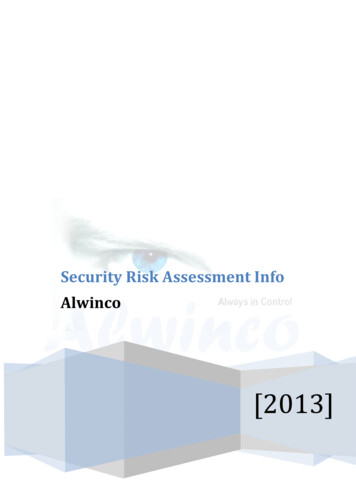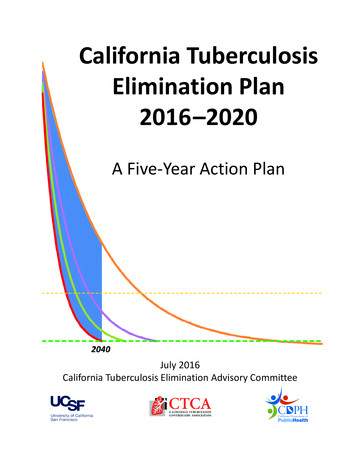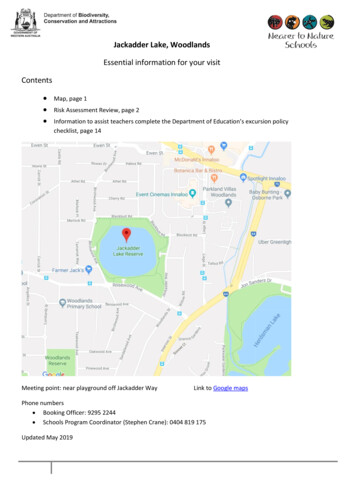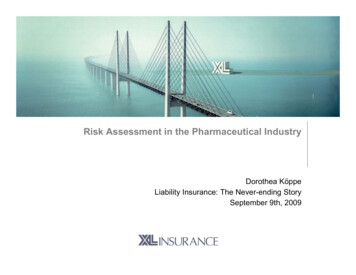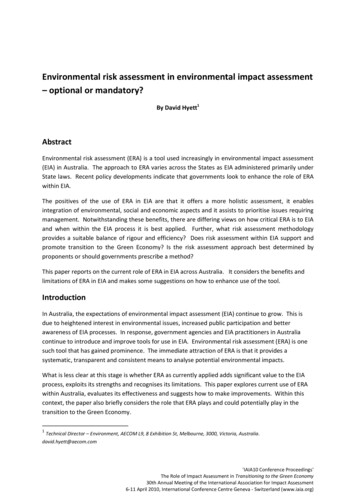
Transcription
Environmental risk assessment in environmental impact assessment– optional or mandatory?By David Hyett1AbstractEnvironmental risk assessment (ERA) is a tool used increasingly in environmental impact assessment(EIA) in Australia. The approach to ERA varies across the States as EIA administered primarily underState laws. Recent policy developments indicate that governments look to enhance the role of ERAwithin EIA.The positives of the use of ERA in EIA are that it offers a more holistic assessment, it enablesintegration of environmental, social and economic aspects and it assists to prioritise issues requiringmanagement. Notwithstanding these benefits, there are differing views on how critical ERA is to EIAand when within the EIA process it is best applied. Further, what risk assessment methodologyprovides a suitable balance of rigour and efficiency? Does risk assessment within EIA support andpromote transition to the Green Economy? Is the risk assessment approach best determined byproponents or should governments prescribe a method?This paper reports on the current role of ERA in EIA across Australia. It considers the benefits andlimitations of ERA in EIA and makes some suggestions on how to enhance use of the tool.IntroductionIn Australia, the expectations of environmental impact assessment (EIA) continue to grow. This isdue to heightened interest in environmental issues, increased public participation and betterawareness of EIA processes. In response, government agencies and EIA practitioners in Australiacontinue to introduce and improve tools for use in EIA. Environmental risk assessment (ERA) is onesuch tool that has gained prominence. The immediate attraction of ERA is that it provides asystematic, transparent and consistent means to analyse potential environmental impacts.What is less clear at this stage is whether ERA as currently applied adds significant value to the EIAprocess, exploits its strengths and recognises its limitations. This paper explores current use of ERAwithin Australia, evaluates its effectiveness and suggests how to make improvements. Within thiscontext, the paper also briefly considers the role that ERA plays and could potentially play in thetransition to the Green Economy.1Technical Director – Environment, AECOM L9, 8 Exhibition St, Melbourne, 3000, Victoria, Australia.david.hyett@aecom.com'IAIA10 Conference Proceedings'The Role of Impact Assessment in Transitioning to the Green Economy30th Annual Meeting of the International Association for Impact Assessment6-11 April 2010, International Conference Centre Geneva - Switzerland (www.iaia.org)
2The methodology involved review of: EIA legislation and associated government guidance for the Australian States of Queensland,New South Wales, Victoria and Western Australia;documentation of eight recent EIA projects across the four States listed above;output of recent reviews or EIA process conducted in Victoria and Western Australia; and,other literature relating to the use of ERA in EIA.As a starting point it is important to define EIA and ERA for the purposes of the following discussion.EIA is a process that involves identification of the impacts of a proposal on the environment(including ecological, social and economic aspects) and evaluation of the importance of thoseimpacts. (Elliot et al, 2009).The term risk has different meanings in different contexts. The International Standard ISO31000defines risk in terms of threats to achieving objectives; that is “the chance of something happeningthat will have an impact on objectives”. Risk management is defined as “the culture, processes andstructures that are directed towards realising potential opportunities whilst managing adverseeffects”. The concepts of risk assessment and risk management are applied in a wide range ofprofessions and disciplines.ERA is one regular application. ERA within an EIA context is the use of risk assessment methods andrisk management procedures to identify and respond to ecological, social and economic issuesassociated with a proposal.An overview of ERA in EIA across AustraliaGoing back ten years, explicit ERA processes were seldom used in EIA processes in Australia. Whererisks were investigated, it was typically with a discipline specific focus. For example a health riskassessment associated with emissions to air or an ecological risk assessment associated withhydrological changes.In recent years there has been a trend towards use of broad based risk assessments as part EIAprocesses. These more holistic, integrated approaches have typically involved: systematic identification of risk pathways linking proposed project activities with potentialecological, social and economic impacts;assigning ratings to identified risks based on potential consequences and likelihood ofoccurrence; and,use of risk ratings as part of the overall assessment and to inform development of mitigationmeasures.The use of broad based risk assessment is supported by key environmental assessment legislation ina number of Australian States, for example the Environmental Planning and Assessment Act 1979 inNew South Wales, the State Development and Public Works Organisation Act 1971 in Queenslandand the Environment Effects Act 1978 in Victoria. However ERA methods are not prescribed in detailin the legislation or associated policies and guidelines.
3As a consequence, use of ERA in EIA has been uneven in its implementation. Examples range fromrudimentary efforts to onerous and detailed methodologies. The primary focus has been on dealingwith potential adverse impacts with little attention given to the positive “Green Economy”opportunities that might be found in individual projects. Accordingly, it is considered that the fullvalue is yet to be extracted from ERA within Australian EIA processes.In a notable recent development, the Western Australian government is in the process of revisingState EIA processes to incorporate a new risk-based approach. Detailed guidelines have beendeveloped and the approach is has been trialled with success in example projects (EPA, 2009).Benefits of the use of ERA in EIATwo key benefits of ERA within EIA, discussed further below, are that it provides a means to: systematically identify potential hazards of a proposal and scope the detailed investigationsrequired for the EIA; and,set EIA priorities and manage uncertainty.Use of ERA to assist with scoping of EIA investigationsThe scoping phase is an early phase of the EIA process that typically involves identification of the keyhazards associated with the project and development of the overall study design. The scoping phaseis when the breadth and the depth of proposed EIA investigations are determined.Hazards are identified by exploring the ways that proposal might interact with the environment. Ahigh-level risk assessment during the scoping phase focussing on key interactions is a useful tool foridentifying the priority hazards for detailed study and separating them from other issues requiringonly limited attention. The benefits of applying ERA during the scoping phase are that it: Provides greater assurance that all significant hazards requiring investigation have beenidentified;Informs preparation of the proposed study program;Ensures that the level of investigations are proportionate to risk; and,Promotes efficiency in the EIA process.Use of ERA to set EIA priorities and to manage uncertaintyERA can play a significant role in managing uncertainty as part of an EIA process. Uncertainty can beinvestigated as part of the process by considering plausible worst case scenarios as part of the ERAmethod. By assigning likelihood and consequence levels taking this approach, the risk assessmentprocess incorporates uncertainty. For example, if it is unknown whether vegetation to be removed ishabitat for an endangered species, for the purposes of the risk assessment it should be assumed thatit is suitable habitat. This approach leads to conservative risk ratings that may overestimate risks butprovides an upper threshold for evaluation of risk.
4This conservative approach is useful because it may reveal that a risk is not significant (even takinginto account of uncertainty). Alternatively it may reveal that based on a conservative assessment arisk is potentially significant. This may prompt: Further data collection or investigation to reduce uncertainty;Investigation of alternative means of carrying out the project that better address the issue;and,Measures to manage uncertainty during project development and implementation phases.Limitations of the use of ERA in EIALimitations of ERA methodsRecognising the limitations of ERA methods enables the level of precision of risk assessment outputto be understood and informs how the output should be used as part of the EIA. ERA methods usedwithin EIA processes in Australia typically involve: Setting the context and compiling background information;Reviewing the project and identifying risk pathways based on conceptual models;Establishing a risk framework including definitions of likelihood and consequence;Assigning risk ratings using expert input often in a risk workshop setting;Reviewing and refining risk ratings; and,Identifying mitigation measures to address key risks.These processes have limitations due to: Different interpretations of terms and concepts by participants;Conceptual models as a basis for risk assessment potentially oversimplify systeminteractions;Linear risk pathways ignore cumulative and synergistic impacts;Incapacity to define risks discretely (because a risk is often a continuum of differentpossibilities); and.Subjectivity of expert input used in the analysis (Burgman, 2005).Effective processes for working across disciplines and providing the opportunity for external inputand validation of risk assessment information can mitigate the limitations of ERA.Purposes for which ERA is not suited within an EIA processFurther, there is a range of impact assessment objectives that ERA methods cannot address.Recognising these limitations of ERA will ensure its appropriate use within the EIA.For example ERA cannot objectively determine whether a risk is acceptable. Most parties will agreeon the risks that clearly acceptable and risks that are clearly unacceptable but because suchjudgments are value laden there will be differing views on the acceptability of in between risks.Some parties are more risk averse than others.
5Additionally, ERA is not particularly suited to evaluating project compliance with legislation andpolicy as part of the EIA process. This is because even if and issue is of low risk, non-compliance withpolicy or legislation may still occur.ERA methodologies also do not deal well with cumulative and synergistic impacts. Becausemethodologies are typically built on linear impact pathways they do not easily address these effects.For example two separate activities having an effect on the same asset. Are the effects mutuallyexclusive or additive?Does ERA within EIA promote transition to a Green Economy?Building the pursuit of sustainability opportunities into EIA processes would assist with the transitionto a Green Economy. More detailed and systematic consideration of renewable energy, watersensitive design, the intensity of greenhouse gas emissions, waste minimization, sustainablematerials and water and energy conservation as part of EIA processes would make a promoteenhanced sustainability outcomes of projects. Can ERA assist in this process?At present use of ERA in Australia is to identify and address potentially adverse impacts of a proposalwithin the context of an approvals process. Its primary motivation is to assist to overcomepotentially negative features of a project rather than drive sustainability. It is understandable andnecessary that the first priority of an EIA process is to ensure that significant harm does not affectecological assets, social values and economic uses. However the tool has wider possibilities.It is telling that the International Standard ISO13000 describes risk management as a means to“realise potential opportunities wills managing adverse effects”. In practice ERA could focus more onsustainability opportunities by: Ensuring that the sustainability objectives for the proposal are clearly set out;Identifying the links between the proposal and enhanced sustainability outcomes; and,Using the ERA method, evaluate the capacity of various initiatives to deliver on theobjectives.This is a significant change in mindset for ERA practitioners and unlike potentially adverse impacts,sustainability opportunities often do not have a regulatory basis. Accordingly pursuit of theseopportunities would rely on voluntary action by proponents.ConclusionsThe use of ERA as part of EIA processes provides a number of benefits, particularly in relation tosystematic identification of hazards, scoping of technical investigations, setting impact assessmentpriorities and managing uncertainty. At the same time ERA methods have limitations and theirrecognition will ensure that practitioners use ERA for suitable purposes and avoid misguidedexpectations.Application of ERA as part of EIA processes in Australia has been uneven and its benefits not fullyexploited. To enhance the effectiveness of ERA in EIA it is suggested that government agencies
6develop more detailed guidelines to provide greater clarity on the expected role and suitablemethods of ERA. This is likely to add to the quality and consistency of ERA within EIA processes. It ismay also provide an assurance that the ERA process adds value and does not become an onerousburden that does not improve EIA outcomes.Further, ERA has received little attention as a tool to assist in the transition to a Green Economy. Thetool has potential to be used for this purpose. In practice adapting existing ERA methods to considerlinks that proposals have with enhanced sustainability outcomes and evaluation of capacity ofidentified initiatives to achieve progress toward sustainability goals would achieve this.ReferencesBurgman M, 2005, Risks and decisions for conservation and environmental management, CambridgeUniversity PressChevron, 2009, Wheatstone Project Environmental Scoping DocumentsCDB Environment, 2009, Gas Pipeline Liddell Power Station Environmental AssessmentDepartment of Sustainability and Environment, 2008, Victorian Desalination Project EnvironmentalEffects StatementDepartment of Sustainability and Environment, 2006, Ministerial guidelines for assessment ofenvironmental effects under the Environment Effects Act 1978Elliot M, Thomas I, 2009, Environmental Impact assessment in Australia: Theory and Practice, theFederation PressEnvironmental Protection Authority, 2009, Review of the Environmental Impact Assessment Processin Western AustraliaEnvironmental Protection Authority, 2009, Environmental Protection Bulletin no. 7 – Risk-basedApproach to EIAInternational Standards Organisation, 2009, ISO31000 Risk Management – Principles and GuidelinesParsons Brinckerhoff, 2008, Camellia and Rosehill Water Recycling Project Environmental AssessmentParsons Brinckerhoff, 2008, Wyaralong Dam Environmental Impact StatementPort of Melbourne Corporation, 2007, Channel Deepening Project Supplementary EnvironmentalEffects StatementSKM, 2007, Traveston Crossing Dam Environmental Impact StatementSKM, 2009, New Acland Coal Mine Stage 3 Expansion Project Environmental Impact StatementVictorian Competition & Efficiency Commission, 2009, A sustainable future for Victoria: GettingEnvironmental Regulation Right
that will have an impact on objectives". Risk management is defined as "the culture, processes and structures that are directed towards realising potential opportunities whilst managing adverse effects". The concepts of risk assessment and risk management are applied in a wide range of professions and disciplines.






